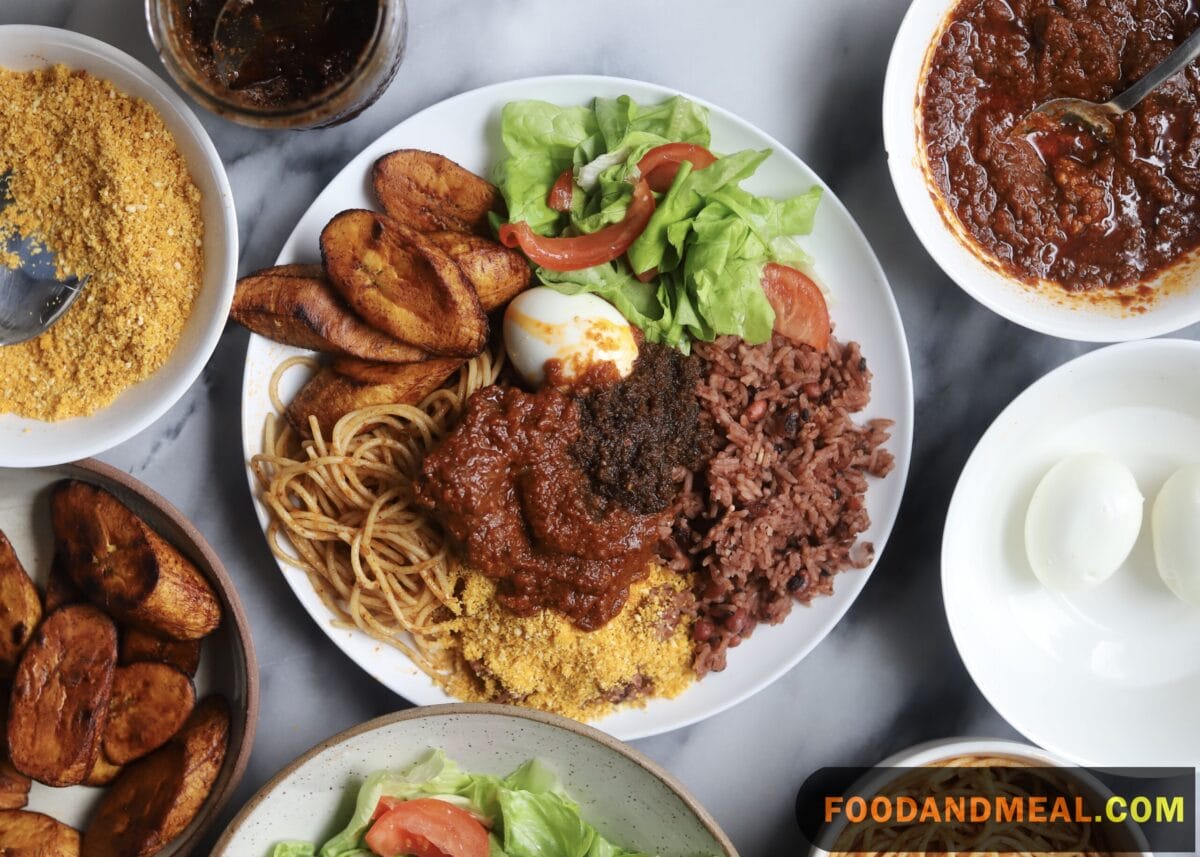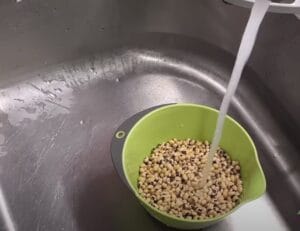This is Kelly Atkinson from Food And Meal, and today I’m thrilled to share with you a recipe that is close to my heart: Waakye. This traditional Ghanaian dish, with its unique blend of beans and rice, has a way of transporting me to a place of warmth and community.
The inspiration to make Waakye comes from a longing to connect with the rich tapestry of African cuisine, to explore the flavors that have sustained generations. It’s about more than just sustenance; it’s about the stories and the heritage that come alive with each simmering pot of this beloved meal.
Waakye is a celebration of simple ingredients coming together to create something extraordinary. The earthy tones of the beans, the subtle bite of the rice, and the vibrant hues of the accompanying sides paint a picture of a land rich in culture and culinary traditions. It’s a dish that speaks of home, of shared meals, and of the joy that comes from gathering around the table.
In preparing Waakye, I find a sense of connection to the hands that have stirred similar pots over open fires, under the vast African sky. There’s a rhythm to the process, a patience required as the flavors meld and mature, telling a story of time-honored cooking methods.
So, join me as we embark on this flavorful journey, where each ingredient is a verse in a much larger narrative. Whether you’re seeking to expand your culinary horizons or simply looking for a comforting meal to share with loved ones, Waakye is a dish that promises to deliver both satisfaction and a touch of adventure. Let’s dive into the world of Ghanaian flavors together, right here at Food And Meal.
About Waakye
Waakye, a Ghanaian treasure, embodies the warmth of home. As you simmer rice and sorghum leaves, savor the comforting aroma that fills the kitchen, evoking memories of tradition. Embrace the delicate balance of flavors, letting the millet leaves weave a unique tapestry. Prepare this dish with a heart full of appreciation for its cultural significance, and let the joy of sharing a piece of Ghanaian heritage enrich your culinary journey.
Waakye recipe of Ghanaian


Waakye (Ghana) Recipe
Equipment
Ingredients
- 3 cups of rice
- 1 ½ cup beans or any kind of beans peas
- salt
- 4 dry sorghum leaves
- 10 cups of water
Instructions
- Wash the beans and soak them in water for 3-4 hours.

- Drain the beans and put them in a large saucepan with partly filled with water. Leave to cook for 45 minutes.

- Wash the sorghum leaves and cut 3 to 4 inches, add to the boiling beans and cook together.

- If the sorghum leaves are not accessible, substitute with a teaspoon of baking soda to give Waakye its distinctive color.
- After 5 minutes, remove the sorghum leaves from the pot.

- Wash the rice thoroughly and add to the beans. Add more water to the pot.

- Cook the mixture for 15-20 minutes.

- Make sure the food does not burn. Stir occasionally while it’s cooking.

- Season with salt
- You can serve with stew, egg or fish, pepper sauce, beef, chicken, and vegetables.

Video
Notes
Nutrition
© Food And Meal
This website provides approximate nutrition information for convenience and as a courtesy only. Nutrition data is gathered primarily from the Spoonacular Database, whenever available, or otherwise other online calculators.
Alternative Method: Preparing Waakye in a Rice Cooker

Start by rinsing rice and black-eyed peas, then combine in the rice cooker with millet leaves or bay leaves. Add water, stir in baking soda, and set the cooker to cook for 20-25 minutes. Meanwhile, mix groundnut paste with water and salt. Once the rice is ready, remove millet leaves, spoon the Waakye onto plates, drizzle with groundnut paste, and garnish with preferred sides. Enjoy this delightful Ghanaian meal of perfectly cooked Waakye.
Tips for making Waakye

Cooking Tips
When it comes to preparing Waakye, a beloved staple in Ghanaian cuisine, there are several cooking tips that can elevate the dish from good to truly memorable. These tips are not just about following steps; they’re about embracing the spirit of the dish and the culture it represents.
The foundation of Waakye is the harmonious combination of rice and beans. Choosing the right type of beans is essential—I recommend using sorghum leaves if available, as they impart a distinct color and subtle flavor that’s characteristic of authentic Waakye. If sorghum leaves are not accessible, dried millet stalks can be a suitable alternative, though the color may vary slightly.
Rinsing the rice until the water runs clear is a step not to be overlooked. This removes excess starch and prevents the grains from clumping together, ensuring that each grain of rice will stand out in the final dish, providing the perfect texture.
Patience is key when cooking the beans. They should be tender and flavorful, which means giving them enough time to soak before cooking and allowing them to simmer gently until they reach the perfect consistency. This slow process allows the beans to absorb the flavors fully, creating a rich and satisfying base for the Waakye.
The spices and seasonings used in Waakye are what truly bring the dish to life. It’s important to find the right balance—too little and the dish may taste flat, too much and it could overwhelm the delicate flavors of the rice and beans. A touch of ginger, garlic, and chili can enhance the dish without dominating it.
Accompaniments are an integral part of the Waakye experience. From the peppery shito sauce to the bright and tangy pickled vegetables, each side dish contributes to the overall flavor profile. My advice is to prepare these sides with care, as they complement and contrast the main dish in delightful ways.
Finally, presentation is not to be underestimated. Serving Waakye in a way that is visually appealing honors the dish and the tradition it carries. Garnish with fresh herbs or slices of avocado for a pop of color and a hint of freshness.
Serving Suggestions

Serving Waakye, a dish steeped in Ghanaian tradition, calls for thoughtful accompaniments that enhance and complement its rich flavors without overwhelming them. A gentle start to the meal could be Miso Soup, with its savory umami character providing a warm introduction. On the side, Gyoza offers a delightful contrast in texture with its crispy exterior and tender filling, while Karaage adds a protein-rich option with its satisfying crunch. Shio Tare, as a simple condiment, can subtly elevate the Waakye’s natural taste. For a creamy counterpart, Egg Salad brings richness with a hint of spice. Bok Choy Soup presents a light and hydrating option, balancing the heartiness of the main dish. To drink, Soy Milk or Rice Milk can mirror the earthy notes of the Waakye, offering a smooth interlude between bites. Ponzu Sauce, with its zesty tang, can serve as an invigorating dip for sides. The crispness of a Daikon Salad cuts through the dish’s richness, and a drizzle of Negi Oil adds a final aromatic flourish. Each element is selected to harmonize with Waakye’s comforting essence, creating a dining experience that is both diverse in flavor and true to its roots.
FAQs About Waakye

- What Are the Millet Leaves Used for? Millet leaves, also known as sobolo leaves, are added to give the Waakye its signature color and a subtle flavor. They are removed before serving.
- Can I Use Canned Black-Eyed Peas? While fresh or dried black-eyed peas are traditional, canned black-eyed peas can be used for convenience. Rinse them thoroughly before cooking.
- How Do I Store Waakye Leftovers? Store any leftover Waakye in an airtight container in the refrigerator. When reheating, add a bit of water to maintain its moisture.
- What Is the Origin of Waakye? Waakye is a beloved Ghanaian dish that can be traced back to the Hausa people of West Africa.
- Can I Make Waakye in Advance? Absolutely! You can make a large batch of Waakye and reheat it as needed. It’s a time-saving option for busy days.
- What is waakye called in English? Waakye is typically referred to as “rice and beans” in English.
- What color is waakye? Waakye is known for its distinctive reddish-brown color, which comes from the use of millet leaves (sobolo leaves) or bay leaves during the cooking process.
- Which ethnic group eats waakye? Waakye is a popular dish among the Ga people of Ghana. It is a significant part of their culinary heritage and is also enjoyed by people from various ethnic backgrounds in Ghana.
- What does waakye taste like? Waakye has a unique and rich flavor profile. The combination of rice, black-eyed peas, millet leaves, and other ingredients imparts a nutty, earthy taste with a hint of spice. The dish is often complemented by the savory and slightly salty taste of the groundnut paste that is drizzled over it.
Conclusion
As we conclude this exploration of Waakye, the heartwarming Ghanaian dish that has been the focus of our culinary journey today, we reflect on the rich tapestry of flavors and traditions that have come together in its creation. The process of making Waakye is a labor of love, a ritual that connects us to the vibrant culture and history of Ghana.
Through this blog post, we’ve shared insights into the art of preparing Waakye, from selecting the right ingredients to perfecting the traditional accompaniments. We’ve emphasized the importance of patience and care at every step, ensuring that the dish you serve is not only delicious but also a true representation of its origins.
At Food And Meal, we are committed to celebrating the diversity of global cuisines, bringing recipes from around the world into your kitchen with authenticity and passion. Waakye is a dish that embodies this spirit, offering a window into the soul of Ghanaian cooking and the communal joy it brings.
We hope that you feel inspired to embrace the adventure of making Waakye, to gather friends and family around your table, and to create memories that will last a lifetime. For more inspiring recipes, cultural insights, and culinary tips, visit us at foodandmeal.com, where every dish is an invitation to explore and every meal is a cherished experience. Thank you for joining us on this flavorful journey, and may your kitchen always be a place of discovery and delight.
I'm Kelly Atkinson, with a passion for dissecting the world of home goods. My reviews stem from thorough testing and a love for sharing detailed insights. Each piece I write offers a glimpse into my explorative journey, aiming to guide readers to informed choices with authenticity and precision, making every review a blend of exploration and expertise.









